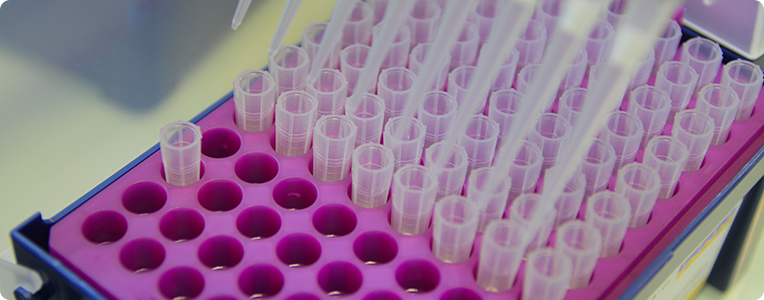Introduction

Organisation and governance
The genomics core facility of the IBENS follows the recommendations of the IBiSA charter, and is operating on a certified quality process. We are member of the national infrasctruture France Génomique, initiated by the governmental program “Investissement d’Avenir”, and we actively participate to developing its technology roadmap.
Our services are open to the scientific community, as well as commercial companies.
Several committees were set up to follow the activities of the core facility throughout time:
- A scientific committee is composed of members of institutes with whom we collaborate the most (within PSL: ENS, Institut Curie, Collège de France; Sorbonne Université). This committee meets once a year suggests strategic orientations concerning equipment and functioning.
- A users committee also meets once a year to discuss the core facility’s results and technological orientations for the future.
-
Internally, a management committee meets every week to check on the status of every projects and functioning of the core facility, and every month to follow the R&D projects that allow us to stay at the state-of-the-art of genomic applications.
Technologies
Since 2010, the genomics core facility proposes high-throughput sequencing with the Illumina short reads technology. Sequencers are regularly renewed to follow technical evolutions. A NextSeq 2000 was acquired in 2021. With this high-throughput sequencing technology, the core facility has focused on applications in functional genomics, with RNA-seq protocols (small quantities, mRNA…)
In 2016, the genomics core facility has acquired the technology MinION of Oxford Nanopore Technologies (ONT). It allows long-reads sequencing, and thereby full-length sequencing of transcripts. This is better suited for certain applications to analyse RNA (splicing, stability, epigenetics). In 2022 we puchased a very high throughput ONT PromethION sequencer to reinforce our offer in long-reads sequencing.
We have acquired in 2017 a Chromium from 10x Genomics. This technology at the scale of single-cells is at the disposal of our collaborators, and enables to sequence RNA in unique cells, on an Illumina sequencer. Since 2022, we propose long-read sequencing in single cells on the ONT technology, to enable a more precise analysis of transcripts.
History
In 1998, Institut Curie, ESPCI and Ecole normale supérieure (ENS Paris), have established one of the first French core facility dedicated to transcriptomic data output and analysis. Once created, the genomics core facility of the Montagne Sainte-Geneviève was aiming at making genomic equipment reachable. The goal is to help laboratories with their high-throughput projects and popularize great-scale technics through the scientific community. By achieving these goals, we are recognized on national scale thanks to approvals from RIO (Réseau Inter Organismes: CNRS, INSERM, INRA et CEA) in 2002, RNG (Réseau National Génopôle) in 2005 and IBiSA (Infrastructures en Biologie Santé et Agronomie) in 2008.
As IBiSA renewed its approval in 2010, the genomics core facility of the Montagne Sainte Geneviève went into partnership with the high-throughput sequencing core facility of the Institut Curie. Genomic Paris Centre was taken on as partner by the France Génomique consortium, which is financed by the governmental funding program “Investissement d’Avenir”. More recently, in 2018, we have extended our activity to microgenomic, and enlarged our perimeter by integrating the high-throughput qPCR facility of ENS. In 2021, the genonics core facilities of Institut Curie and ENS have been renewed thier IBiSA approval indenpendly; the ENS genomics core facility has been renamed as GenomiqueENS.
Our activity started with DNA microarrays. From 2002 to 2006, more than 8,000 microarrays were produced: pan-genomic DNA chips (mouse, yeast, fruit fly) and more specific projects (diatoms, nervous system development in mouse, repeated and CGH regions in human). These microarrays were related to more than 130 projects across 9 European countries, with users mainly from research institutes, hospitals and universities. Thanks to the improvement of the manufactured microarrays’ quality and the decrease of their costs, we transferred our local production to external suppliers – Agilent and Nimblegen – in 2006. Facing the rise of high-throughput sequencing in 2010, we gradually moved from DNA microarrays to RNA sequencing, ending our support for biochips in 2013.
From 2007, high-throughput sequencing has brought about a revolution in the genomic landscape. We have participated in this transition in 2008 with trial projects and we chose to emphasize on the data analysis automation. It was only in 2010 that we decided to invest in a high-throughput sequencing machine – an Illumina HiSeq – that was installed in spring 2011.
We have upgraded to a NextSeq 500 in 2015, then a NextSeq 2000 in 2021. This choice has enabled us to acquire one of the most flexible and reliable device on the market at the time, but also to offer help in data analysis to our users as soon as the opening of our sequencing activity. We have conducted more than 280 projects comprising more than 3,200 samples from 2015 to 2020. Since 2016, we also provide long read sequencing based on the Oxford Nanopore Technologies sequencers.
